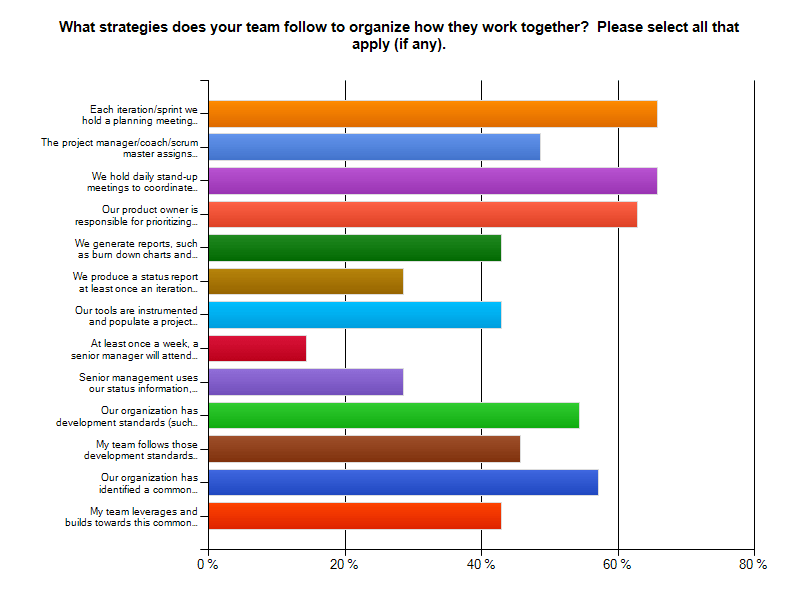How Agile Are You?: 2013 Open Research
 |
This open research into how agile people really are was performed during the last week of December 2012 and January 2013 and there was 174 respondents. The survey was announced via a link to the survey was posted on my IT Surveys home page at Ambysoft.com/surveys/, announced on my Twitter feed, my mailing list (ambysoft@yahoogroups.com), the Agile and Lean and Disciplined Agile Delivery (DAD) discussion groups on LinkedIn. |
The Survey Results
The goal of the survey was to explore how well “agile teams” were at meeting the five agile criteria (Is the team delivering value? Is the team validating its own work? Is the team working closely with their stakeholders? Is the team self-organizing? Is the team improving their process?) which I’ve used for several years now to judge whether teams claiming to be agile actually are.
Some findings include:
- 91% of teams that claim to be agile are providing value to stakeholders on a regular basis, see Figure 1 for details. This was calculated by considering any team who claimed to produce working software every sprint OR they had one or more iterations without working software at the beginning.
- 88% of teams that claim to be agile are validating their own work, see Figure 2 for details. This was calculated by considering any team that claimed to perform their own regression testing on a regular basis OR performed TDD at the design level OR performed TDD at the requirements level.
- 99% of teams that claim to be agile are working closely with stakeholders, see Figure 3 for details. This was calculated by considering any team that claimed to have a product owner who represents the stakeholder community OR that works with specific stakeholders, particularly domain experts, on an as needed basis OR who has access to stakeholders, or their representatives, on a daily basis.
- 72% of teams that claim to be agile are self organizing, see Figure 4 for details. This was calculated by considering any team that claimed to hold iteration planning meeting AND daily stand up (coordination) meetings.
- 92% of teams that claim to be agile are improving the process that they follow throughout the lifecycle, see Figure 5 for details. This was calculated by considering any team that claimed to hold retrospectives at the end of each iteration OR several times throughout a project.
- Teams that claim to be agile often aren’t. Figure 6 shows that only 65% of agile teams meet the five agile criteria, although 82% meet all but the self-organization criteria.
- Teams which are moving towards agile but aren’t there yet are reasonably close. Figure 7 shows that 39% of those teams meet all five agile criteria and 65% meet all but self-organization.
Figure 1. Agile criterion: Value.

Figure 2. Agile criterion: Validation.

Figure 3. Agile criterion: Stakeholder involvement.

Figure 4. Agile criterion: Self organization.

Figure 5. Agile criterion: Continuous improvement.

Figure 6. How agile are teams which claim to be agile?

Figure 7. How agile are teams which are working on becoming agile?

Downloads
What You May Do With This Information
You may use this data as you see fit, but may not sell it in whole or in part. You may publish summaries of the findings, but if you do so you must reference the survey accordingly (include the name and the URL to this page). Feel free to contact me with questions. Better yet, if you publish, please let me know so I can link to your work.
Discussion of the Results
- I am fairly liberal in my willingness to consider whether or not a team meets the criteria, so the results are probably overly positive. I wanted it to be as easy as possible “to be agile” and even then a sufficiently large percentage of people claiming to be on agile teams may not be.
- People didn’t know the purpose of the survey, so that likely removed some bias. My strategy for the DDJ surveys is to send out a short survey every two months entitled “State of the IT Union, DATE” but to not indicate what the topic of the survey actually is (other than an IT topic of course).
- This survey suffers from the fundamental challenges faced by all surveys.
Links to Other Articles/Surveys
Why Share This Much Information?
I’m sharing the results, and in particular the source data, of my surveys for several reasons:
- Other people can do a much better job of analysis than I can. If they publish online, I am more than happy to include links to their articles/papers.
- Once I’ve published my column summarizing the data in DDJ, I really don’t have any reason not to share the information.
- Too many traditionalists out there like to use the “where’s the proof” question as an excuse not to adopt agile techniques. By providing some evidence that a wide range of organizations seem to be adopting these techniques maybe we can get them to rethink things a bit.
- I think that it’s a good thing to do and I invite others to do the same.
